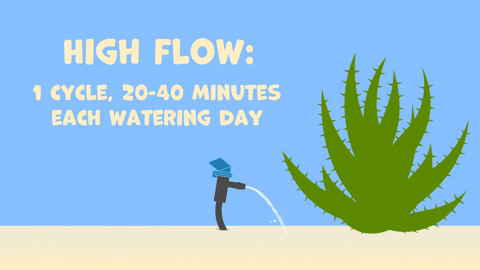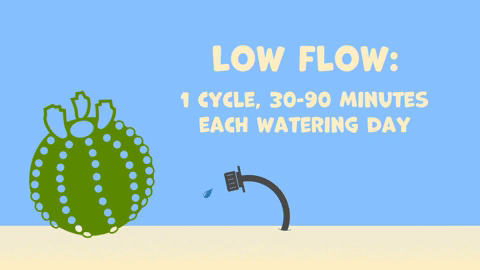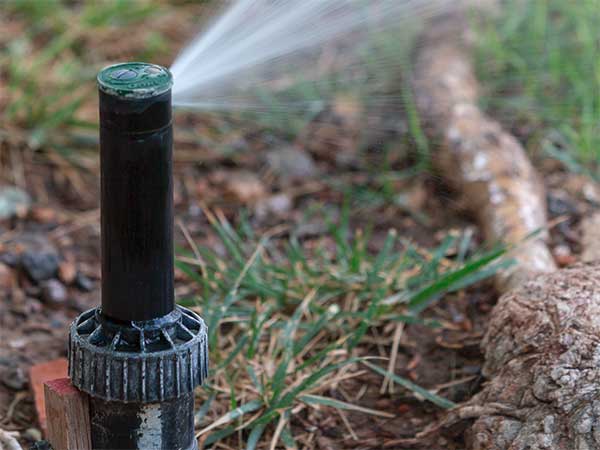Watering tips
Plants and trees need MUCH LESS WATER than grass. Not sure what the difference is between sprinklers and drip irrigation? You aren't alone.
When it comes to landscapes, watering isn't "one size fits all." How long and often you water your landscape depends largely on the type of plants, shrubs and irrigation components you have. It also varies by time of year.
Whether you have sprinklers or drip irrigation — or both — it's important to know the difference between them, how they work, and when to use them.
💧 Drip watering
Drip irrigation is truly beneficial to plants in desert environments. Drip irrigation systems deliver water more slowly and efficiently, and they should run longer but less frequently than sprinkler systems.
The length of each watering should be determined by the emitter flow rate, soil type, and weather conditions.
It's easy to accidentally over-water your plants on drip systems! Use the information on this page to determine the correct run times for your landscape. Looking for tips on designing and maintaining your drip system? Visit SNWA.com for more information and to sign up for a free drip irrigation class.
How often to water
Seasonal watering restrictions apply to customers with drip irrigation systems. While drip irrigation may occur any day of the week, the number of days is limited by season.
Plants need far less water than grass. Here's how we recommend you run drip irrigation systems during each season:
- Winter: One day a week or less
- Spring and Fall: Two days a week
- Summer: Four days a week
Remember to avoid Sunday watering and comply with seasonal watering restrictions—or face a water waste fine.
How long to water
Determine the amount of time to water based on the rate of flow of your drip emitters.


| Emitter type | Length of each watering |
|---|---|
| High-flow emitter (Up to 20 gph) | 20 - 40 minutes or less |
| Low-flow emitter (Up to 4 gph) | 30 minutes or less |
| Low-flow emitter (Up to 2 gph) | 60 minutes or less |
| Low-flow emitter (Up to 1 gph) | 90 minutes or less |
High-flow or low-flow? Don't know?
- Low-flow: Beads on tip or drips slowly
- High-flow: Streams like a water fountain
- gph: Gallons per hour, often marked on the emitter head. There are many emitter types.
💦 Sprinkler watering
Sprinklers are a perfect match for your grass. That's because they water short and sweet! They work in gallons per minute, and they don't mess around.
How to water grass
For lawns watered by sprinklers, water no more than 12 minutes total. On your assigned watering days, water in three 4-minute cycles, with about an hour between each cycle if using pop-up sprinklers. Water for about 12 minutes each watering cycle if using rotating sprinkler heads.
When to water
Winter: Water during the warmer part of the day to prevent freeze and avoid afternoon winds. For example, 8, 9 and 10 a.m.
Spring: 5, 6, and 7 a.m., for four minutes each time. Turn off your sprinklers on those rainy spring days!
Summer: Water overnight or around dawn to minimize the amount of water lost to evaporation. For example. 5, 6, and 7 a.m. And remember to add watering days gradually as temperatures get hotter. Start with three to four days in May, then increase watering days only as needed in June, July and August. Never water on Sunday!
Fall: As early fall days are still quite warm, continue watering overnight or around dawn. For example, four minutes apiece at 5, 6, and 7 a.m.
Regardless of the season, never water on Sundays!
Sprinkler types
The amount of water needed to maintain your lawn depends on the sprinkler system you have.
Pop-up (most common)

- 3- to 4-inch pop-ups
- Sprays water over large areas
- Run 3 cycles, 4 minutes each
Stream rotor (less common)

- Applies water more slowly.
- Sprays water over smaller areas
- Run 3 cycles, 8 minutes each
Seasonal tips
An important part of a healthy, beautiful landscape is efficient watering for the appropriate season.
- Mandatory winter watering restrictions: During the winter, sprinkler irrigation is limited to one assigned day per week. Watering restrictions also apply to drip irrigation. Sunday is not an optional watering day. Find your watering day.
- Drip watering: Drip systems deliver water more slowly and efficiently than sprinklers, which means plants on drip irrigation should be watered less often than grass irrigated by sprinklers. Get more drip tips.
- Sprinkler watering: Water your lawn a maximum of 12 minutes on your watering day. Water in three 4-minute cycles with each cycle spaced out an hour. Get more sprinkler tips.
- Change all your clocks when Daylight Saving Time ends: Don't forget to change the time on your irrigation clock when daylight saving time ends on the first Sunday in November. Even better—get a rebate for a smart irrigation controller that will do it for you!
- Midmorning watering: Water in the midmorning to avoid the afternoon winds that keep your sprinklers from hitting their grass target. You also will reduce the risk of icing that can occur if you water during early morning or evening.
- Save water on rainy days: Turn your irrigation clock off on rainy days or let a smart irrigation clock do the work for you.
